Vignarola Romana, a Roman spring vegetable dish. Spring... the moment it was officially announced it immediately snowed 15 cm here in Brussels. Nevertheless, we keep finding the most beautiful artichokes, both baby artichokes and recently even Roman artichokes in the shops and markets.
I was never an artichoke-kind-of-girl, did not know how to cook them or what to make of them, until I met 'My Roman' and his family who effortlessly converted me to them and even taught me how to cook them properly. And just to remember those suitcases full of Roman artichokes (= carciofi, pronounced 'carjoffee') they would bring when visiting us in Brussels... see pictures of the 'real things'... they were so beautiful that I used them as flower-decoration on the table while we were having the others for dinner.
At this point we are artichoke-crazy. We have them almost every week, stuffed with mint and garlic (= 'Carciofi alla Romana') - just the thought of the perfume of these three ingredients makes me want more - artichoke frittata, and of course, Vignarola Romana. Chatelaine market has a pasta stand with fantastic artichoke ravioli. What I haven't tried yet is artichoke lasagna, and my own home-made artichoke ravioli... but now I know the art of undressing and de-choking them, nothing can stop me :-)
As for the Italian ingredients: traditionally the dish is made in Italy in Spring, and during the short time when all vegetables are in season at the same time and of course packed with Roman flavours. The ones I find here in Brussels are also pretty tasty, and these gorgeous purple-green tulip-shaped beauties definitely make up in their pretty looks for what they potentially may lack in flavour versus their Roman cousins. They are very tasty, cook very tender and have almost no furry chokes or thistle spikes.
Vignarola is originally made with Guanciale, an Italian bacon, and that adds an interesting flavour to the dish. But also pancetta works quite well. I did leave out the salad though as included in the original recipe. We just weren't so keen on the wilted leaves in the dish, but must try it next time. The Romans also have a special mint = mentuccia that is a lot more flavoursome, with small, intensely flavoured leaves. Needless to say I could not find it here and used normal mint instead.
Although I used fresh fava beans I did cheat with frozen peas in the end. The dish with all it's peeling and shelling is rather time-consuming, and although I usually find the monotonous cooking tasks like cutting, peeling, kneading, stirring, etc very relaxing, especially after a long day's work (no walls to paint at this time unfortunately...). I just could not face to peel 555 peas as well as preparing the rest.
Tip for buying and storing artichokes: make sure the artichokes are well closed and feel heavy for their size. Touch to judge: squeeze at the roundest part: if the artichoke is good and fresh it should feel very firm and hardly give. If it squeezes easily, don't buy it. In case of brown leaf tops, the artichoke might have been subjected to frost, which means it might be even tastier. If not using artichokes immediately they can be put in a plastic-bag and stored in the fridge. They will keep fresh for several days.
(Below quantities don't have to be so accurate, but there should be roughly equal amounts of artichokes, fava beans and peas)
2 lemons
7 small (baby) artichokes
1/4 cup extra virgin olive oil
app. 60g guanciale (or pancetta)
1 red onion
3 spring onions
1 - 1 1/2 tsp dried oregano
1 1/4 tsp salt, or more to taste
1 1/2 cups shelled fresh fava beans (or frozen)
2 cups frozen peas (or shelled fresh)
1/4 cup chopped parsley
2 Tbsp chopped mint, or more for a more minty flavour
1-1.5 tsp lemon juice to taste
freshly ground black pepper
Prepare the artichokes app. 1 hour before cooking the dish: fill a large bowl halfway with cold water, then squeeze the lemons into the water, keeping a little juice back for later. Cut 1 1/2 of the lemons into slices and add them to the water. Cut the remaining half into 2 quarters, using 1 quarter to rub the inside of your hands, which will help to prevent the artichokes from discolouring when being touched, the second quarter to rub the cut surfaces of the artichokes. Prepare the artichokes: first of all cut off the stem very close to the artichoke base. (These small artichokes have a rather tender stem so you can use it also for the dish, in which case slice off the outer skin layer of the stem with a sharp knife, then half lengthwise and cut into smaller pieces). Next, pull back and then snap off just as many outer hard leaves until the revealed artichoke leaves become softer and lighter.

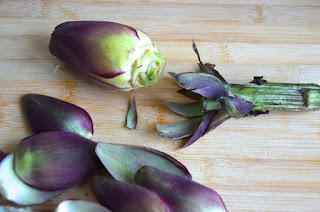
Trim the base underneath the leaves to create a nice round shape then cut off the top hard and spiky part of the leaves, app. 3 cm.
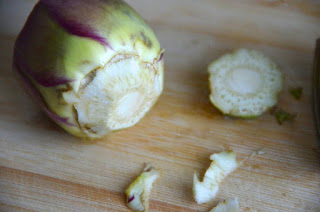

Rub all cut surfaces with the lemon quarter to avoid discolouration. Cut the artichoke in half, and then into quarters. With a small sharp knife remove the inner hairy choke, if exists, then cut each artichoke quarter into 2 wedges.
Put them immediately into the water until ready to use. Any artichokes peeled or in progress should be put into the lemon-water while not used.
Peel the fava beans: I think it's best to do this by feeling the pod for a bean and then snapping the pod right in front of the bean. Then pinch the pod so that the bean squeezes out. Snap off the pod in front of the next bean, squeeze, and so on, until all the beans have been removed from the pod. Remove the small green attachments.
Cut the guanciale into small dice. Peel and cut the onion into small cubes. Wash the spring onion and cut into rings, including the green parts. Heat the olive oil in a large pan over medium heat. Add the Guanciale, onions and spring onions and fry until translucent for app. 10 mins, stirring occasionally. Remove the lemon pieces from the artichokes water, then drain the artichokes and add them to the pan together with 2 cups of water and the salt.


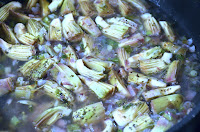
Bring to a boil, then reduce the heat and simmer until the artichokes are soft, app. 20-25 minutes. Add the fava beans and peas and cook until tender for another 5 minutes (frozen beans and peas will take less time, app. 2 minutes). Chop the mint and parsley and add to the finished dish.
Add a drizzle of lemon juice, season with freshly milled black pepper and add more salt if necessary. Serve drizzled with a little olive oil. We also like it with a couple of shavings of Pecorino Romano.
________________________________________________________
VIGNAROLA ROMANA -
ROMAN SPRING VEGETABLE DISH



Serves 6 as a first course
(Below quantities don't have to be so accurate, but there should be roughly equal amounts of artichokes, fava beans and peas)
2 lemons
7 small (baby) artichokes
1/4 cup extra virgin olive oil
app. 60g guanciale (or pancetta)
1 red onion
3 spring onions
1 - 1 1/2 tsp dried oregano
1 1/4 tsp salt, or more to taste
1 1/2 cups shelled fresh fava beans (or frozen)
2 cups frozen peas (or shelled fresh)
1/4 cup chopped parsley
2 Tbsp chopped mint, or more for a more minty flavour
1-1.5 tsp lemon juice to taste
freshly ground black pepper
Prepare the artichokes app. 1 hour before cooking the dish.
1) Prepare lemon-water: Fill a large bowl halfway with cold water, then squeeze the lemons into the water, keeping a little juice back for later. Cut 1 1/2 of the lemons into slices and add them to the water. Cut the remaining half into 2 quarters, using 1 quarter to rub the inside of your hands, which will help to prevent the artichokes from discolouring when being touched, the second quarter to rub the cut surfaces of the artichokes.
2) Prepare the artichokes:
First of all cut off the stem very close to the artichoke base. (Small artichokes have a rather tender stem so you can use them also for the dish, in which case slice off the outer skin layer of the stem with a sharp knife, then half lengthwise and cut into smaller pieces).
Next, pull back and then snap off just as many outer hard leaves until the revealed artichoke leaves become softer and lighter.
Trim the base underneath the leaves to create a nice round shape.
Then cut off the top hard and spiky part of the leaves, app. 3 cm.
Rub all cut surfaces with the lemon quarter to avoid discolouration.
Cut the artichoke in half, and then into quarters.
With a small sharp knife remove the inner hairy choke, if exists.
Cut each artichoke quarter into 2 wedges.
Put the artichokes immediately into the water until ready to use. Any artichokes peeled or in progress should be put into the lemon-water while not used.
3) Peel the fava beans: I think it's best to do this by feeling the pod for a bean and then snapping the pod right in front of the bean. Then pinch the pod so that the bean squeezes out. Snap off the pod in front of the next bean, squeeze, and so on, until all the beans have been removed from the pod. Remove the small green attachments.
4) Prepare the remaining ingredients:
Cut the guanciale into small dice. Peel and cut the onion into small cubes.
Wash the spring onion and cut into rings, including the green parts.
5) Fry the guanciale, onions and spring onions: Heat the olive oil in a large pan over medium heat. Add the Guanciale, onions and spring onions and fry until translucent for app. 10 mins, stirring occasionally.
6) Add the artichokes, water and salt: Remove the lemon pieces from the artichokes water, then drain the artichokes and add them to the pan together with 2 cups of water and the salt.
7) Simmer: Bring to a boil, then reduce the heat and simmer until the artichokes are soft, app. 20-25 minutes.
8) Add the fava beans and peas: Add the fava beans and peas and cook until tender for another 5 minutes (frozen beans and peas will take less time, app. 2 minutes).
9) Add the herbs: Chop the mint and parsley and add to the finished dish.
10) Finish the dish: Add a drizzle of lemon juice, season with freshly milled black pepper and add more salt if necessary.
11) Serve: Serve drizzled with a little olive oil. We also like it with a couple of shavings of Pecorino Romano.




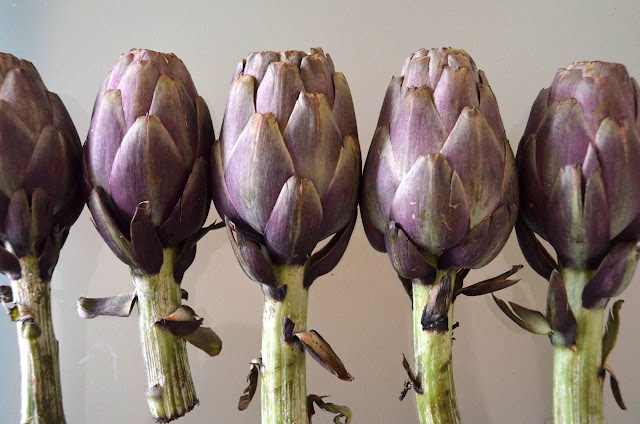

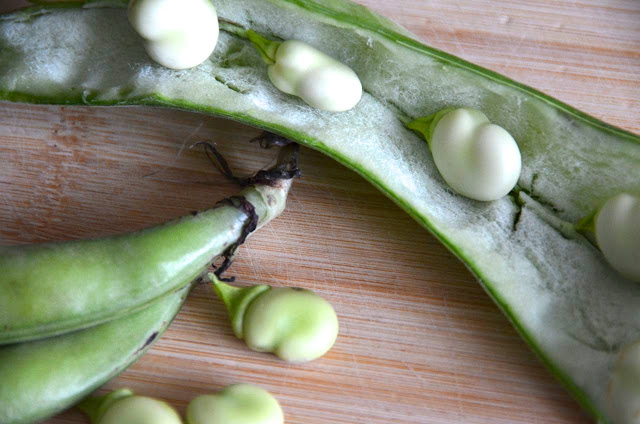






No comments:
Post a Comment